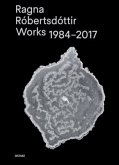The Austrian artist Astrid Esslinger presents a compilation of her work from 2003 to the present day with this volume. She has worked as a freelance artist since 1987. Until then she participated in artistic projects of the Linz artist collective Stadtwerkstatt. Her work can be divided into three parallel phases: her early pieces with textile materials and her later paintings with acrylic colors on canvas as well as pieces using an original technique developed for her work while on journeys, cut outs.
The text contribution by Birgit Rinagl concentrates on Esslinger’s paintings which explore the themes of men and women, public and private, work and free time, nature and city as well as life and death. Tom Waibel discusses the subversive character of her hand luggage productions and brings light to their dark and ironic side. The introduction by Fina Esslinger, an art historian and the daughter of the artist, gives the reader the necessary background knowledge on motifs and the theoretical framework of the works, encouraging the reader to enjoy Esslinger’s artistic output.
Die österreichische Künstlerin Astrid Esslinger ist seit 1987 als freischaffende Künstlerin tätig. Sie legt hiermit eine Bestandsaufnahme ihrer Werke von 2003 bis heute vor.Ihr Werk kann in drei, teilweise gleichzeitigen, Phasen und Gruppen gesehen werden: die frühen textilen Arbeiten, die späteren Malereien mit Acryl auf Leinwand sowie die von der Künstlerin auf Reisen originär entwickelte Form der "Handgepäckproduktion", den "Cut Outs". Den Malereien widmet sich der Textbeitrag von Birgit Rinagl, die Esslingers Bilder auf ihre Themen hin untersucht: Frau und Mann, Privat und Öffentlich, Arbeit und Freizeit, Natur und Stadt sowie Leben und Tod. Tom Waibel geht auf den subversiven Charakter der "Handgepäckproduktion" ein und beleuchtet sowohl ihre dunkle als auch ihre ironisierende Seite. Die Einleitung von Fina Esslinger, Kunsthistorikerin und Tochter der Künstlerin, stattet den Leser mit dem nötigen Hintergrundwissen zu Motiven und theoretischen Grundlagen aus und eröffnet dem Leser so einen weiteren Zugang zu Esslingers Werk.
The text contribution by Birgit Rinagl concentrates on Esslinger’s paintings which explore the themes of men and women, public and private, work and free time, nature and city as well as life and death. Tom Waibel discusses the subversive character of her hand luggage productions and brings light to their dark and ironic side. The introduction by Fina Esslinger, an art historian and the daughter of the artist, gives the reader the necessary background knowledge on motifs and the theoretical framework of the works, encouraging the reader to enjoy Esslinger’s artistic output.
Die österreichische Künstlerin Astrid Esslinger ist seit 1987 als freischaffende Künstlerin tätig. Sie legt hiermit eine Bestandsaufnahme ihrer Werke von 2003 bis heute vor.Ihr Werk kann in drei, teilweise gleichzeitigen, Phasen und Gruppen gesehen werden: die frühen textilen Arbeiten, die späteren Malereien mit Acryl auf Leinwand sowie die von der Künstlerin auf Reisen originär entwickelte Form der "Handgepäckproduktion", den "Cut Outs". Den Malereien widmet sich der Textbeitrag von Birgit Rinagl, die Esslingers Bilder auf ihre Themen hin untersucht: Frau und Mann, Privat und Öffentlich, Arbeit und Freizeit, Natur und Stadt sowie Leben und Tod. Tom Waibel geht auf den subversiven Charakter der "Handgepäckproduktion" ein und beleuchtet sowohl ihre dunkle als auch ihre ironisierende Seite. Die Einleitung von Fina Esslinger, Kunsthistorikerin und Tochter der Künstlerin, stattet den Leser mit dem nötigen Hintergrundwissen zu Motiven und theoretischen Grundlagen aus und eröffnet dem Leser so einen weiteren Zugang zu Esslingers Werk.


